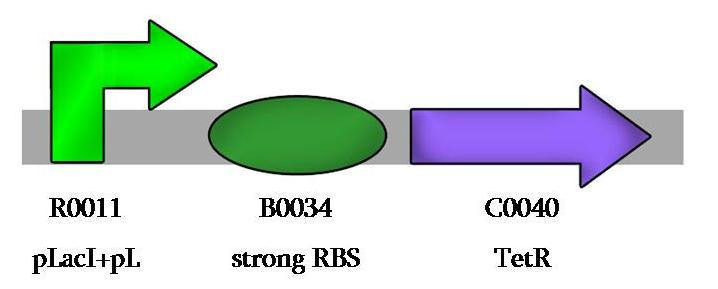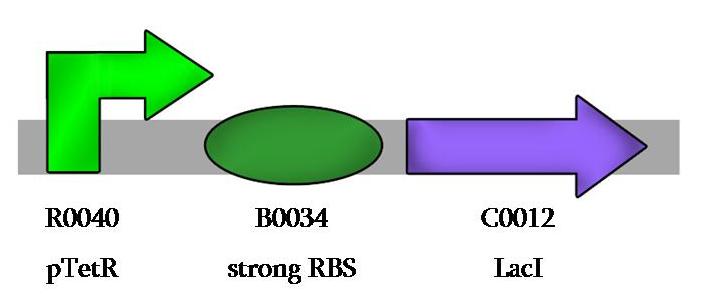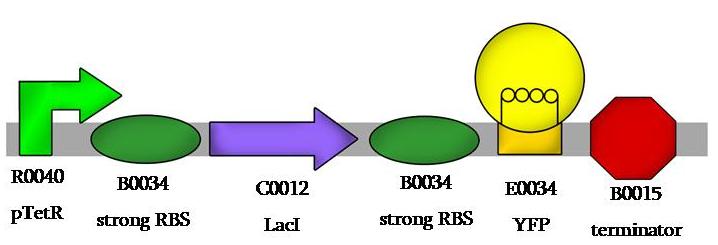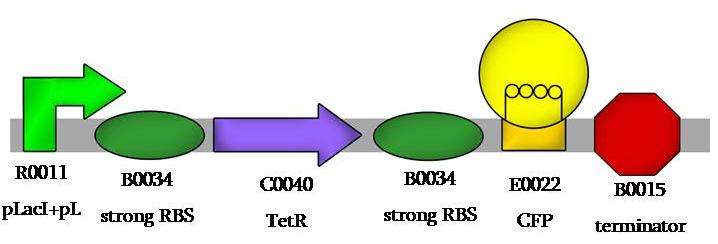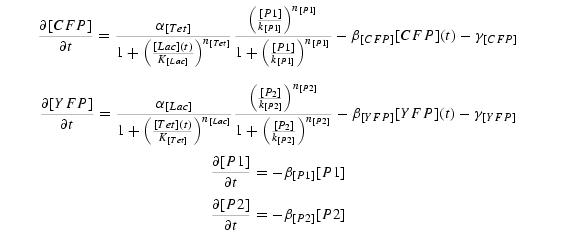Valencia/Results
From 2007.igem.org
(→Theoretical development) |
|||
| (14 intermediate revisions not shown) | |||
| Line 1: | Line 1: | ||
{{Valencia/Cabecera}} | {{Valencia/Cabecera}} | ||
| - | In this section | + | In this section we try to summarize all the results obtained in the development of the project, this section has been divided in an experimental and a theoretical part. For a more extended description of the developed work we suggest to visit the sections in silico work and lab work. |
| + | |||
| + | ==Experimental achievements== | ||
| + | |||
| + | We have obtained many new constructions, some of them sequenced and checked. | ||
| + | |||
| + | The parts we have succesfully ligated are: | ||
| + | <center> | ||
| + | [[Image:VPlac-tet retocat.jpg|350px]] | ||
| + | [[Image:VPtet-lac retocat.jpg|350px]] | ||
| + | </center> | ||
| + | this two different parts make up [http://partsregistry.org/Part:BBa_I730012 the comparator]. They were fully sequenced with 100% identities with what they ''had to be'', you can have the fasta files here: [https://static.igem.org/mediawiki/2007/7/77/VPLac-TetR_iGEM_Valencia_Team.txt pLac-TetR] and [https://static.igem.org/mediawiki/2007/c/ce/VPTet-LacI_iGEM_Valencia_Team.txt pTet-LacI]. | ||
| + | <center> | ||
| + | [[Image:VPtet-lac-fluor retocat.jpg|400px]] | ||
| + | [[Image:VPlac-tet-fluor retocat.jpg|400px]] | ||
| + | </center> | ||
| + | we planned to have fluorescence as ouputs of our device, so we sticked together CFP and YFP... | ||
| + | <center> | ||
| + | [[Image:VPompr-plac-tet retocat.jpg|500px]] | ||
| + | </center> | ||
| + | we had many problem assembling pOmpR to the previous constructs with fluorescence, so we went through the alternative way: assembling first pOmpR and then the fluorescences. | ||
| + | |||
| + | ===Future experiments=== | ||
| + | We will first start validating our model. We will use pOmpR as both inputs of the system and asses the dynamic behaviour of the system as well as experiments varying the osmolarity of the medium. This way we hope to define the values of our equations, thus taking the leap from an effective model to a model that describes more correctly the system we work on. | ||
| + | |||
| + | Then, with this corrected model, we will be able to precisely study the differences between pOmpR and pOmpRm and to calibrate them. This way, we could also use this model to make some good predictions about what parameters we could tune in order to make the system behave the way we want. | ||
| + | |||
| + | Once we have calibrated pOmpR and pOmpRm, we will aim to a third variant of this promoter that will have different strenght. | ||
| + | |||
| + | ==Theoretical development== | ||
| + | |||
| + | *An effective model to describe and analyze the behaviour of our system has been developed. | ||
| + | |||
| + | *This model is composed by the following set of equations: | ||
| + | <center> | ||
| + | [[Image:VEcmodelo.JPG]] | ||
| + | </center> | ||
| + | |||
| + | *The parameters of the model have unknown values, as a consequence of this, the values taken by Elowitz were selected as a first approximation to their real value. | ||
| + | |||
| + | *According to this an stability and sensibility analysis of the E.coliRuler according the different parameter values has been been performed. | ||
| + | |||
| + | *After developing the facs measurements, in principle we should be able to give a better estimation of the values of the model parameters. So, preparing that part of the project in advance, a strategy to determine those constants has been designed. | ||
Latest revision as of 15:43, 26 October 2007
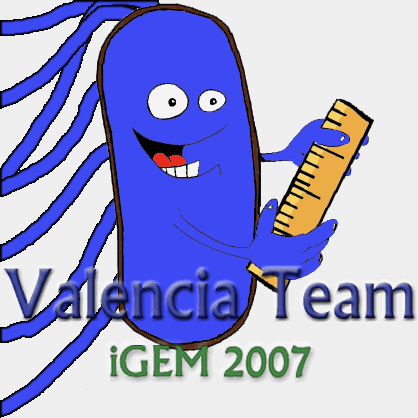
|
|
In this section we try to summarize all the results obtained in the development of the project, this section has been divided in an experimental and a theoretical part. For a more extended description of the developed work we suggest to visit the sections in silico work and lab work.
Experimental achievements
We have obtained many new constructions, some of them sequenced and checked.
The parts we have succesfully ligated are:
this two different parts make up [http://partsregistry.org/Part:BBa_I730012 the comparator]. They were fully sequenced with 100% identities with what they had to be, you can have the fasta files here: pLac-TetR and pTet-LacI.
we planned to have fluorescence as ouputs of our device, so we sticked together CFP and YFP...
we had many problem assembling pOmpR to the previous constructs with fluorescence, so we went through the alternative way: assembling first pOmpR and then the fluorescences.
Future experiments
We will first start validating our model. We will use pOmpR as both inputs of the system and asses the dynamic behaviour of the system as well as experiments varying the osmolarity of the medium. This way we hope to define the values of our equations, thus taking the leap from an effective model to a model that describes more correctly the system we work on.
Then, with this corrected model, we will be able to precisely study the differences between pOmpR and pOmpRm and to calibrate them. This way, we could also use this model to make some good predictions about what parameters we could tune in order to make the system behave the way we want.
Once we have calibrated pOmpR and pOmpRm, we will aim to a third variant of this promoter that will have different strenght.
Theoretical development
- An effective model to describe and analyze the behaviour of our system has been developed.
- This model is composed by the following set of equations:
- The parameters of the model have unknown values, as a consequence of this, the values taken by Elowitz were selected as a first approximation to their real value.
- According to this an stability and sensibility analysis of the E.coliRuler according the different parameter values has been been performed.
- After developing the facs measurements, in principle we should be able to give a better estimation of the values of the model parameters. So, preparing that part of the project in advance, a strategy to determine those constants has been designed.

